Cravat, die Krawatte
© by Darko Zubrinic, Zagreb (1995)
Ivan Gundulic (1589-1638) with his cravat in 1622. Source: Acadmia Cravatica.
The earliest known usage of cravat in history is by Ivan Gundulic (1589-1638), a famous Croatian poet from the City of Dubrovnik. Note that Gundulic died the year when the French emperor Louis XIV was born.
Croatian soldiers served
in many European armies since the
seventeenth century. So in the French army in the 17th century, during
the reign of Louis XIII, there was a cavalry composed exclusively of
the Croats, called Royal -
Cravate, which existed in the
period
of 1664-1789. These soldiers gave the world something that is today
unavoidable in fashion: the tie,
called la cravate
by
the French and by the Germans die
Krawatte - the expression was
coined from the Croatian name, and mentioned for the first time in
1651. The name has entered into
- Italian - Cravatta
- Spanish - Corbata
- Catalonian - Corbata
- Filipino - Korbata
- Portuguese - Gravata
- Croatian - Kravata
- Irish - Carabhat
- French - Cravate
- Basque - Gorbata
- Persian (Iran) - Kravata
- German - Crawatte
- English - Cravat
- Welsh - Crafat
- Swedish - Kravatt
- Finnish - Kravatti
- Flemish - Krawaat
- Danish - Kravata
- Dutch - Kravata
- Norwegian - Krawatt
- Swedish - Krawatt
- Estonian - Kravata
- Norwegian - Cravat
- Greek - Gravata, γραβάτα
- Polish - Krawat
- Ukrainian - Kravatka
- Czech - Kravata
- Slovakian - Kraváta
- Slovenian - Kravata
- Albanian - Kravatë
- Romanian - Cravată
- Serbian - Kravata
- Turkish - Kravat
- Lithuanian - Cravat
- Afrikaans - Krawat
- Galician - Gravata
- Japanese - Kravato
- Malay - Cravat
- Vietnamese - Cà vạt, Cravat
- Nepali - Krova
- Haitian Creole - kravat
- Sudanese - Cravat
- Swahili - Cravat
- Telugu (India) - Cravat
- Esperanto - Kravato
and many other.
So when you wear a tie,
remember its Croatian origin.
Many variants of the Croatian name can be found in old documents (for more information see eg. [Klaic, Hrvati i Hrvatska]):
Crovat, Cravat (-> cravate), Crobat, Corbat, Krabat,
Charwath, Crawat, Krawat, Churbate, Grawat,
Charwaten, Corbetha, Curewate, Corwate,
Chrowat, Crowat, etc.
In Italy one can encounter the second names of Cravati, Cravatti, Cravetto, Cravedi, Craviotto, Croattimi, Croatto, obviously all of them derived from the Croatian name. You can easily check this in Italian phone books.
The name of HRVATA for cravate can be heared in Croatia in the regions of Lika and in Ravni Kotari near Zadar. HRVATA is derived from the name of Hrvat = Croat.
It is interesting that in the Swedish capital Stockholm there is a district called Krabaten. It is a result of participation of Croats in the Thirty Year's War (17th century). In the Stockholm military museum there are several Croatian flags from that war. On the southern bank of lake Vänren in Sweden there is a beautiful palace of Läckö where you can see traditional Croatian, Dalmatian and Slavonian coats of arms (Austrian room, No 165), painted around 1680. By the way, it is interesting that Ban (viceroy) Ivan VI Frankapan lived for about seven years at the Royal Court in Sweden in the first half of the 15th century.
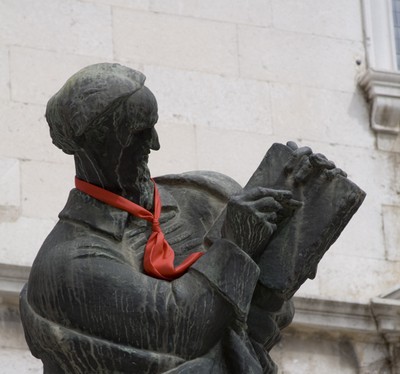
Monument of Marko Marulic of Split (1450-1524), a famous Croatian writer from 15th-16th centuries, decorated by a nice cravate. Carved by Ivan Mestrovic in 1924. Photo by Jelena Popic.
Here is an interesting message forwarded to me by mr. Tomislav Petricevic (Zagreb) in 2002, concerning the Swedish word krabat, that he obtained from one of his Swedish colleagues:
The word is [one] krabat, [many] krabater, and [that] krabaten, [those] krabaterna. The meaning of the word is a "small, active, alert child", nowadays usually exclusively referring to a little boy. It is indeed derived from the word Croat and has been used in the Swedish language since c. 1620, so your dating the word to the 30 years' war is correct. It arrived in our language via (low) German. The same word is used in the form [one] kravatt, [many] kravatter, for (neck)tie, although this is of somewhat later origin and came to the Swedish language around 1716 from the French cravate, a Croatian scarf, as used by the Croatian soldiers. I checked this information with the dictionary of the current edition of the Swedish Encyclopedia, of which I'm an editor.
I learned that the Croats share one more interesting word with Swedes: poriluk (leek). Information by dr. Zvonimir Sipus.
A part of Vienna, capital of Austria, at Spittelberg (7. Bezirk), was since 1609 known as Krawattendörfl or Krowottendörfl, according to different Austrian dialects. It is insteresting that Austrian general Isolano (Johann Ludwig Hektor Isolano, 17th century), had three houses there, and his troups were composed of Croats that brought the cravate to the world. Many thanks to Mr. Mijo Juric, Vienna, for this information.
It is interesting that the Croatian town of Slavonski Brod on river Sava appears on a map of the Habsburg Empire from 1697 with its center indicated as Cravatten Statt. The map was prepared by Nikola Sparr de Bensdorf from the Netherlands, and is kept in the Military Archives in Vienna.
Baron Trenck (1711-1749) was probably the most famous Croatian soldier who took part in the war of the Austrian Succession. He was the head of a regiment of Pandours recruited largely in Slavonia. His Memoirs of the Illustrious Francis Bacon Trenck were first printed in German and then translated into English (London, 1747).
It is little known that a famous French King Louis XIV (1638-1715) had his cravatier du roi. Cravatier du roi had a very serious and important duty in the state administration: to offer the King a basket full of finest cravats every morning! See [Peroche], p. 121. The King himself wore cravate, see here. Note that he was born the same year when Ivan Gundulic died.
Interesting impressions about the Croats can be seen in "The Journey" written by Thomas Watkins, published in London in 1792 (second edition in 1794). He praises Croatian soldiers (Esclavonian soldiers) and sailors. He was enthralled by the beauty of Dubrovnik, its hospitality, competent administration, high level of education and scholarship found among many of its inhabitants. He also cited some of the verses that the Dubrovnik poets addressed to him as a guest. Talking about inhabitants of Dalmatia, he stated that they are ``in their attire and manners not unlike highland Scots - bold, honest, simple and so incured to inclement weather that even now, when the snow is 4 inches high, some of them (as I can see from my window) spend the night round a small fire in the open'' (see [Mardesic], p. 186).
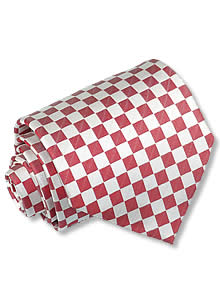
Cravate
with pattern of Croatian
coat of arms,
photo from www.croata.hr
Two Croatian regiments of Royal Cravate were under the French flag in military operations undertaken by Napoleon I in Russia. Especially important was their insurance of Napoleon's retreat from Russia across Berezino in 1812/13. More than two thirds of the Croats lost their lives: 400 soldiers and 10 officers, plus 357 dead of famine and freezing. Only 296 survived. According to Marmont, Napoleon declared: ``I never had more courageous and better soldiers''. According to [Dolbeau], p 18, Napoleon addressed the following message to these 296 Croatian survivors:
Hier, j'ai pu m'assurer de mes propres yeux de votre courage et de votre fidélité. Vous avez acquis la gloire immortelle et l'estime, et je vous place parmi mes meilleurs troupes. Pour votre courage, je vous promets de vous accorder tout ce que vous me demanderez de bon droit lorsque nous serons de retour. Je suis satisfait de vous, très satisfait.
Demobilized in 1814, only several officers stayed in France, like the "fameux général" Marko Sljivaric, comte de Heldenburg (1762-1838), who became commander of the city of Antibes.
In the French Military Museum in Paris (Maison des Invalides) there is a memorial tablet containing the following words (``To the memory of Croatian regiments that under the French flag have shared the glory of the French Army''):

|
|
The historical tragedy of the Croats was that they had to fight against each other in opposing armies, like in French and Austrian army, Turkish, Venetian.
In Turkish language Kravat has two meanings: a tie, and in wrestling (which is very popular in this country) kravat is the headlock move.
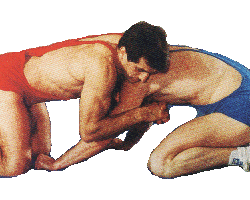
Kravat - Source
I remember as a child, while playing and wrestling with my friends, we used the name kravata also in this "wrestling" sense. Believe it or not, in Polish language the following operation in rugby and in eastern combat sports is called krawat:
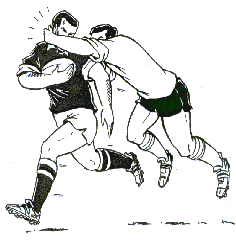
Krawat - Source
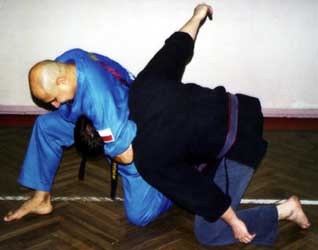
Krawat (mae jime) - Source
The term cravat, cravate, for headlock wrestling move, is used in French, English, Italian, Turkish, Croatian, Polish, and probably in many other languages.
Two of the most common ways to tie a cravat knot are long style:

and Manhattan style (source, a nice web page for children, written in Czech - Vazeni panove, dekuju Vam moc!):

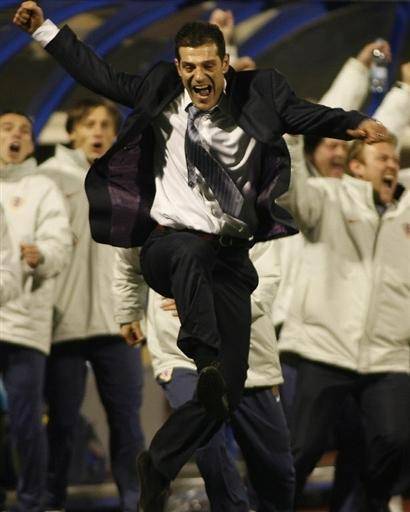
Slaven Bilic,
coach of the Croatian soccer
representation, celebrating a victory in 2007. His cravate is also in
full swing.
In Luxemburg there is a hotel called Grand Hotel CRAVAT.

DO NOT TURN YOUR BACK TO CROATIA
Designed
by Boris Ljubičić


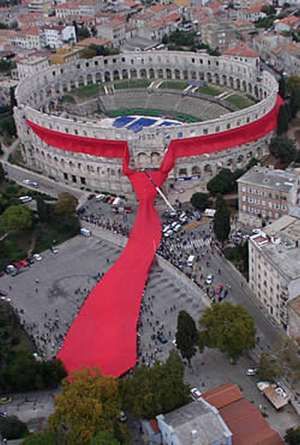
CRAVATE AROUND ARENA IN PULA,
2003
the largest cravat in the world,
weighing 450 kg, 808 m long, maximal width 25 m,
tied around Arena in Pula, Istria, Croatia. The knot itself was tied
at the height
of 21 meters, and was 15 meters wide!
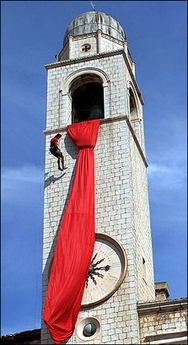
Cravate around the City Bell in Dubrovnik, 2006
Links:
- Academia Cravatica
- A remarkable Address given by a Croatian Minister to those going to war, and due to its excellency translated into German, Dutch (in the Hague!), Swedish in 1778, and into Latvian in 1804.
- Royal Cravattes by Zvonko Z. Springer, Salzburg, Austria
- Croatia - homeland of the cravats
- Croatian soldiers aid Britain against Napoleon
- It is interesting that Thomas Fink from the University of Cambridge defended his doctoral thesis in physics dealing with - ties! Also a recent monograph has been issued devoted to various applications of ties in science: The 85 Ways to Tie a Tie: The Science and Aesthetics of Tie Knots, by Thomas Fink Yong Mao Fourth Estate: 1999.
- Nicholas B. Daddazio's Cravat Sculpture as icon and symbol of Western Culture
- Prva smjesna straže Kravat pukovnije, 2, 3
Acknowledgment. Many thanks to professors Patrick F. Hodnett (Ireland), Carlos Braumann (Portugal), Mrs. Violi Calvert (Philippines), and Dr. Clea F. Rees (Wales) for their information about "cravat" in respective languages. Sead Muhamedagic (Zagreb) learned from his colleague Ebtehaj Navaey from Iran that the Persion name for cravat is Kravata.
Croatia - an overview of its History, Culture and Science
